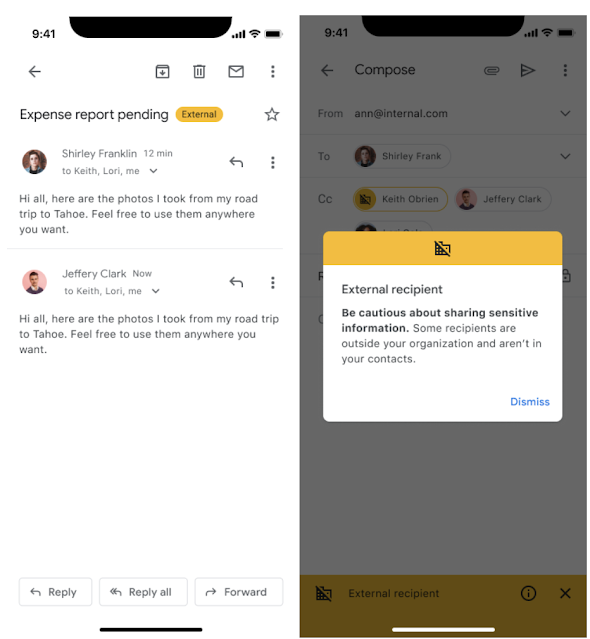New updates
Unless otherwise indicated, the features below are fully launched or in the process of rolling out (rollouts should take no more than 15 business days to complete), launching to both Rapid and Scheduled Release at the same time (if not, each stage of rollout should take no more than 15 business days to complete), and available to all Google Workspace and G Suite customers.
See collaborator avatars in the toolbar of apps on Android devices
Pin table headers when using pageless format on Google Docs
When your Google Doc is set to the pageless format, you can now pin one or more table rows as header rows. When you scroll vertically past the top of the table, the headers will remain visible at the top of the window until you scroll to the bottom of the table. |
Learn more.
Easily share files in Google Meet chat on web
Currently, when you share the link to a Google Drive file in Meet chat, you have to ensure the document is shared with those on the call, either proactively or reactively, on a separate screen. Starting this week, when sharing a file in Meet chat, you will now be prompted to update the file sharing permissions to reflect which meeting attendees you’d like to have access to a particular file, all within Meet. | Roll out to Rapid Release and Scheduled Release domains began December 5, 2022 at an extended pace (potentially longer than 15 days for feature visibility). |
Learn more.
Warning banners for external email recipients on iOS devices
Beginning today, you'll see a warning banner when adding external recipients to an email on iOS. These warnings are
already available for Gmail on the web and Android devices. Note that admins can
turn these specific warning labels on or off for their organization. | Roll out to Rapid Release and Scheduled Release domains began December 9, 2022 at an extended pace (potentially longer than 15 days for feature visibility).

Improvements for using Miro in Google Meet
We've made two enhancements for the Miro experience within Google Meet:
- Meeting participants will see a dialog invite instead of a chat message asking them to join a whiteboarding session.
- Meeting hosts now have the option to end collaboration for the group as a whole. Alternatively, meeting participants will have the ability to leave the session individually.
We hope these improvements create a smoother collaborative experience when using Miro within Google Meet. | Learn more
here and
here.
Previous announcements
The announcements below were published on the Workspace Updates blog earlier this week. Please refer to the original blog posts for complete details.
More ways to prevent data exfiltration on iOS devices
In 2020, we released
several data exfiltration protections for iOS devices. Today, we’re announcing the next set of enhancements for data exfiltration protections for iOS. We’re expanding these
security controls to give admins more ways to protect sensitive company data on iOS devices. | Available to Google Workspace Enterprise Standard, Enterprise Plus, Enterprise for Education, and Cloud Identity Premium customers only. |
Learn more.
New default setting for content managers to modify shared drives coming in February 2023
Starting this week, admins will see a new shared drive setting that can be enabled or disabled to give content managers the ability to share folders in shared drives. In February 2023, all content managers will have the ability to share folders by default. If you’d like this feature to remain off for end users, disable the setting now. | Available to Google Workspace Essentials, Business Standard, Business Plus, Enterprise Essentials, Enterprise Standard, Enterprise Plus, Education Fundamentals, Education Plus, Education Standard, the Teaching and Learning Upgrade, and Nonprofits, as well as legacy G Suite Business customers only. |
Learn more.
Create drop-down chips in Google Sheets
We’ve added dropdown chips in Google Sheets, a custom formatting feature that is already available in Docs. They also enable you to easily indicate statuses or various project milestones outlined in your Sheet. |
Learn more.
Collaborate with colleagues in Google Slides through a new ‘Follow’ feature
We’re introducing a new ‘Follow’ feature that allows you to collaborate with colleagues in real-time on Google Slides. Simply, click on a collaborator’s avatar in the Slides toolbar to jump to whatever slide they are on, and continue to move with them as they navigate and make changes to a presentation. |
Learn more.
Completed feature rollouts